Numerical and Experimental Investigation of the Decoupling Combustion Characteristics of a Burner with Flame Stabilizer
Abstract
:1. Introduction
2. Burner Specifications
3. Numerical Modeling
3.1. Domain and Mesh
3.2. Numerical Models
3.3. Simulated Cases and Boundary Conditions
3.3.1. Comparison between DLNB and LNB
3.3.2. DLNB Structure Optimization
3.4. Model Validation
3.5. Separation Characteristics Analysis Method
4. Results and Discussion
4.1. Comparison between DLNB and LNB
4.1.1. Separation Characteristics Comparison
4.1.2. Combustion Characteristics Comparison
4.2. DLNB Structure Optimization
4.2.1. Flow-Field and Separation Characteristics
4.2.2. Combustion Characteristics
4.2.3. NOx Characteristics
4.3. DLNB Structure Optimization Summary
5. Conclusions
- (1)
- The simulation results show that the separation and combustion capacities of the DLNB were preferred for the low-volatile coal over the LNB. The presence of a flame holder in the DLNB nozzle divides the coal/air flow into three streams, forming a long and stable pulverized coal bundle that provides beneficial ladder-shaped spontaneously steady combustion and ensures stable combustion ability.
- (2)
- Through optimization of the DLNB burner structure, the partition plate structure with a flat plate exhibited satisfying performance. It achieved a coal-rich/lean concentration ratio of 22.94 and reduced the average NOx emission concentration at the outlet by 59.37% compared to the initial design structure. As for combustion, DLNB shows ladder-shaped spontaneously steady combustion state, ensuring the combustion efficiency under low load. The outstanding low-NOx properties can be attributed to the long and robust penetrated char bundle, which enhances the decoupling combustion and effectively utilizes highly reductive volatile and char components to reduce NOx formation.
Author Contributions
Funding
Data Availability Statement
Acknowledgments
Conflicts of Interest
References
- Min, K.; Li, Z. Review of gas/particle flow, coal combustion, and NOx emission characteristics within down-fired boilers. Energy 2014, 69, 144–178. [Google Scholar]
- Tan, H.; Niu, Y.; Wang, X.; Xu, T.; Hui, S. Study of optimal pulverized coal concentration in a four-wall tangentially fired furnace. Appl. Energy 2011, 88, 1164–1168. [Google Scholar] [CrossRef]
- Kurose, R.; Ikeda, M.; Makino, H. Combustion characteristics of high ash coal in a pulverized coal combustion. Fuel 2001, 80, 1447–1455. [Google Scholar] [CrossRef]
- Kurose, R.; Ikeda, M.; Makino, H.; Kimoto, M.; Miyazaki, T. Pulverized coal combustion characteristics of high-fuel-ratio coals. Fuel 2004, 83, 1777–1785. [Google Scholar] [CrossRef]
- Kurose, R.; Makino, H.; Suzuki, A. Numerical analysis of pulverized coal combustion characteristics using advanced low-NOx burner. Fuel 2004, 83, 693–703. [Google Scholar] [CrossRef]
- Kurose, R.; Tsuji, H.; Makino, H. Effects of moisture in coal on pulverized coal combustion characteristics. Fuel 2001, 80, 1457–1465. [Google Scholar] [CrossRef]
- Yang, W.; Wang, B.; Lei, S.; Wang, K.; Chen, T.; Song, Z.; Ma, C.; Zhou, Y.; Sun, L. Combustion optimization and NOx reduction of a 600 MWe down-fired boiler by rearrangement of swirl burner and introduction of separated over-fire air. J. Clean. Prod. 2019, 210, 1120–1130. [Google Scholar] [CrossRef]
- Li, Z.; Liu, G.; Zhu, Q.; Chen, Z.; Feng, R. Combustion and NOx emission characteristics of a retrofitted down-fired 660 MW utility boiler at different loads. Appl. Energy 2011, 88, 2400–2406. [Google Scholar] [CrossRef]
- Song, L.; Chen, Z.; He, E.; Jiang, B.; Li, Z.; Wang, Q. Combustion characteristics and NOx formation of a retrofitted low-volatile coal-fired 330 MW utility boiler under various loads with deep-air-staging. Appl. Therm. Eng. 2017, 110, 223–233. [Google Scholar]
- Fang, Q.; Wang, H.; Zhou, H.; Lei, L.; Duan, X. Improving the Performance of a 300 MW Down-Fired Pulverized-Coal Utility Boiler by Inclining Downward the F-Layer Secondary Air. Energy Fuels 2010, 24, 4857–4865. [Google Scholar] [CrossRef]
- Lun, M.; Fang, Q.; Peng, T.; Cheng, Z.; Gang, C.; Lv, D.; Duan, X.; Chen, Y. Effect of the separated overfire air location on the combustion optimization and NO x reduction of a 600 MW e FW down-fired utility boiler with a novel combustion system. Appl. Energy 2016, 180, 104–115. [Google Scholar]
- Ma, L.; Fang, Q.; Lv, D.; Zhang, C.; Chen, Y.; Chen, G.; Duan, X.; Wang, X. Reducing NOx Emissions for a 600 MWe Down-Fired Pulverized-Coal Utility Boiler by Applying a Novel Combustion System. Environ. Sci. Technol. 2015, 49, 13040–13049. [Google Scholar] [CrossRef] [PubMed]
- Kuang, M.; Li, Z.; Liu, C.; Zhu, Q.; Zhang, Y.; Wang, Y. Evaluation of overfire air behavior for a down-fired 350 MWe utility boiler with multiple injection and multiple staging. Appl. Therm. Eng. 2012, 48, 164–175. [Google Scholar] [CrossRef]
- Shi, X.; Qian, E.; Shi, H.; Zheng, C. Investigation of the Optimization of Slit Width for a Slitted Bluff-body Burner: Pulverized Coal Ignition and Flame Stabilization. Combust. Sci. Technol. 1997, 124, 1–15. [Google Scholar]
- Hao, Z.; Yu, Y.; Liu, H.; Hang, Q. Numerical simulation of the combustion characteristics of a low NOx swirl burner: Influence of the primary air pipe. Fuel 2014, 130, 168–176. [Google Scholar]
- Wang, X.; Tan, H.; Yan, W.; Wei, X.; Niu, Y.; Hui, S.; Xu, T. Determining the optimum coal concentration in a general tangential-fired furnace with rich-lean burners: From a bench-scale to a pilot-scale study. Appl. Therm. Eng. 2014, 73, 371–379. [Google Scholar] [CrossRef]
- Zhou, H.; Cen, K.; Fan, J. Two-Phase Flow Measurements of a Gas−Solid Jet Downstream of Fuel Rich/Lean Burner. Energy Fuels 2005, 19, 64–72. [Google Scholar] [CrossRef]
- Maier, H.; Spliethoff, H.; Kicherer, A.; Fingerle, A.; Hein, K.R.G. Effect of coal blending and particle size on NOx emission and burnout. Fuel 1994, 73, 1447–1452. [Google Scholar] [CrossRef]
- Shi, X.; Qian, R.; Zhen, Y.; Ma, X. A new principle of ignition and flame stability for low-volatile pulverized coal with slitted bluff-body burner. Int. J. Energy Res. 2015, 20, 933–941. [Google Scholar]
- Wei, X.; Xu, T.; Hui, S. Burning low volatile fuel in tangentially fired furnaces with fuel rich/lean burners. Energy Convers. Manag. 2004, 45, 725–735. [Google Scholar] [CrossRef]
- Cai, L.; Xiao, S.; Gao, S.; Yin, W.; Dong, L.I.; Guangwen, X.U. Low-NOx coal combustion via combining decoupling combustion and gas reburning. Fuel 2013, 112, 695–703. [Google Scholar] [CrossRef]
- Smoot, L.D.; Hill, S.C.; Xu, H. NOx control through reburning1This mini-review paper was presented, together with a series of other review papers, at the Tenth Annual Technical Conference of the Advanced Combustion Engineering Research Center, held in Salt Lake City, Utah, in March 1997.1. Prog. Energy Combust. Sci. 1998, 24, 385–408. [Google Scholar]
- Kramlich, J.C.; Cole, J.A.; McCarthy, J.M.; Lanier, W.S.; McSorley, J.A. Mechanisms of nitrous oxide formation in coal flames. Combust. Flame 1989, 77, 375–384. [Google Scholar] [CrossRef]
- Wang, J.; Zheng, K.; Singh, R.; Lou, H.; Hao, J.; Wang, B.; Cheng, F. Numerical simulation and cold experimental research of a low-NOx combustion technology for pulverized low-volatile coal. Appl. Therm. Eng. 2017, 114, 498–510. [Google Scholar] [CrossRef]
- Kobayashi, H.; Howard, J.B.; Sarofim, A.F. Coal devolatilization at high temperatures. Symp. Combust. 1977, 16, 411–425. [Google Scholar] [CrossRef]
- Chen, H. Research on Stable Combustion Technology of Boiler Burning Inferior Coal at Low Load. Master’s Thesis, North China Electric Power University, Beijing, China, 2013. [Google Scholar]
- Gururajan, V.S.; Wall, T.F.; Gupta, R.P.; Truelove, J.S. Mechanisms for the ignition of pulverized coal particles. Combust. Flame 1990, 81, 119–132. [Google Scholar] [CrossRef]
- Wang, J.; Lou, H.H.; Yang, F.; Cheng, F. Numerical simulation of a decoupling and Re-burning combinative Low-NOx coal grate boiler. J. Clean. Prod. 2018, 188, 977–988. [Google Scholar] [CrossRef]
- Gandhi, M.B.; Vuthaluru, R.; Vuthaluru, H.; French, D.; Shah, K. CFD based prediction of erosion rate in large scale wall-fired boiler. Appl. Therm. Eng. 2012, 42, 90–100. [Google Scholar] [CrossRef]
- Zhu, Q. Study on NOx Generation Mechanism of Large Boiler and Flame Denitration Numerical Simulation of Burner. Ph.D. Thesis, Huazhong University of Science and Technology, Wuhan, China, 2001. [Google Scholar]
- He, J. Experimental Study of NO Emission in Combustion of Coal in Fixed Bed. J. Heilongjiang Inst. Sci. Technol. 2013, 23, 21–25. [Google Scholar]
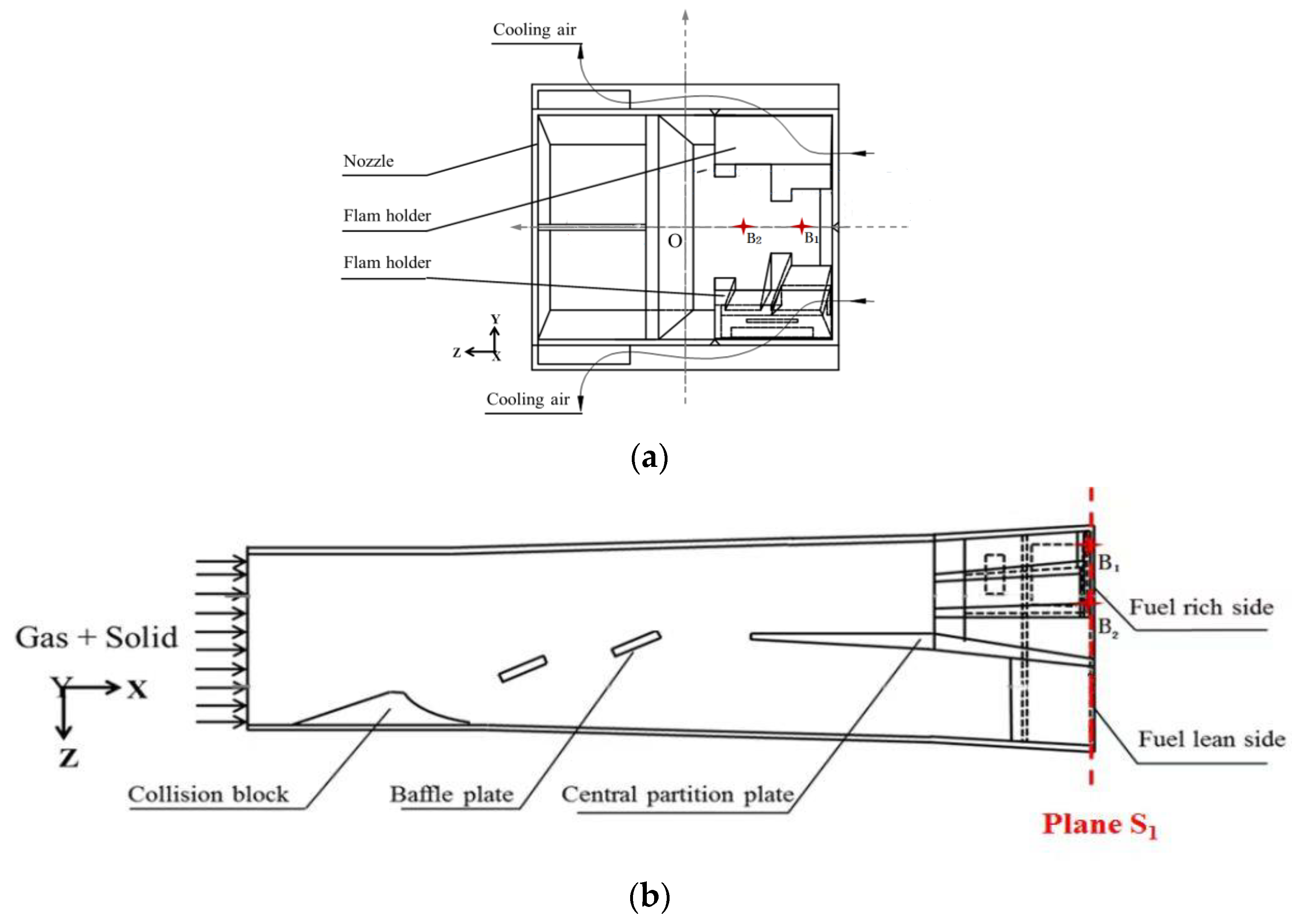
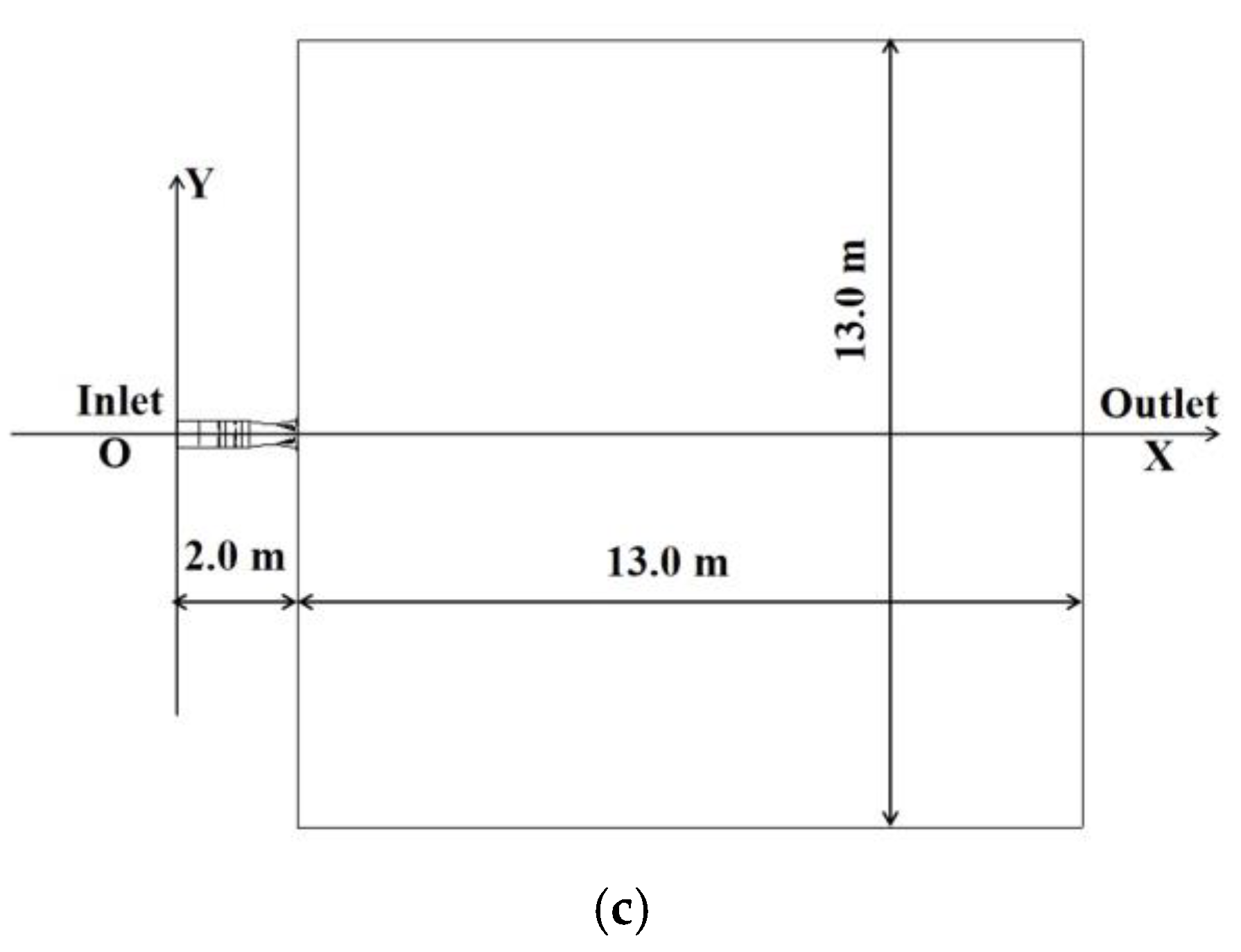
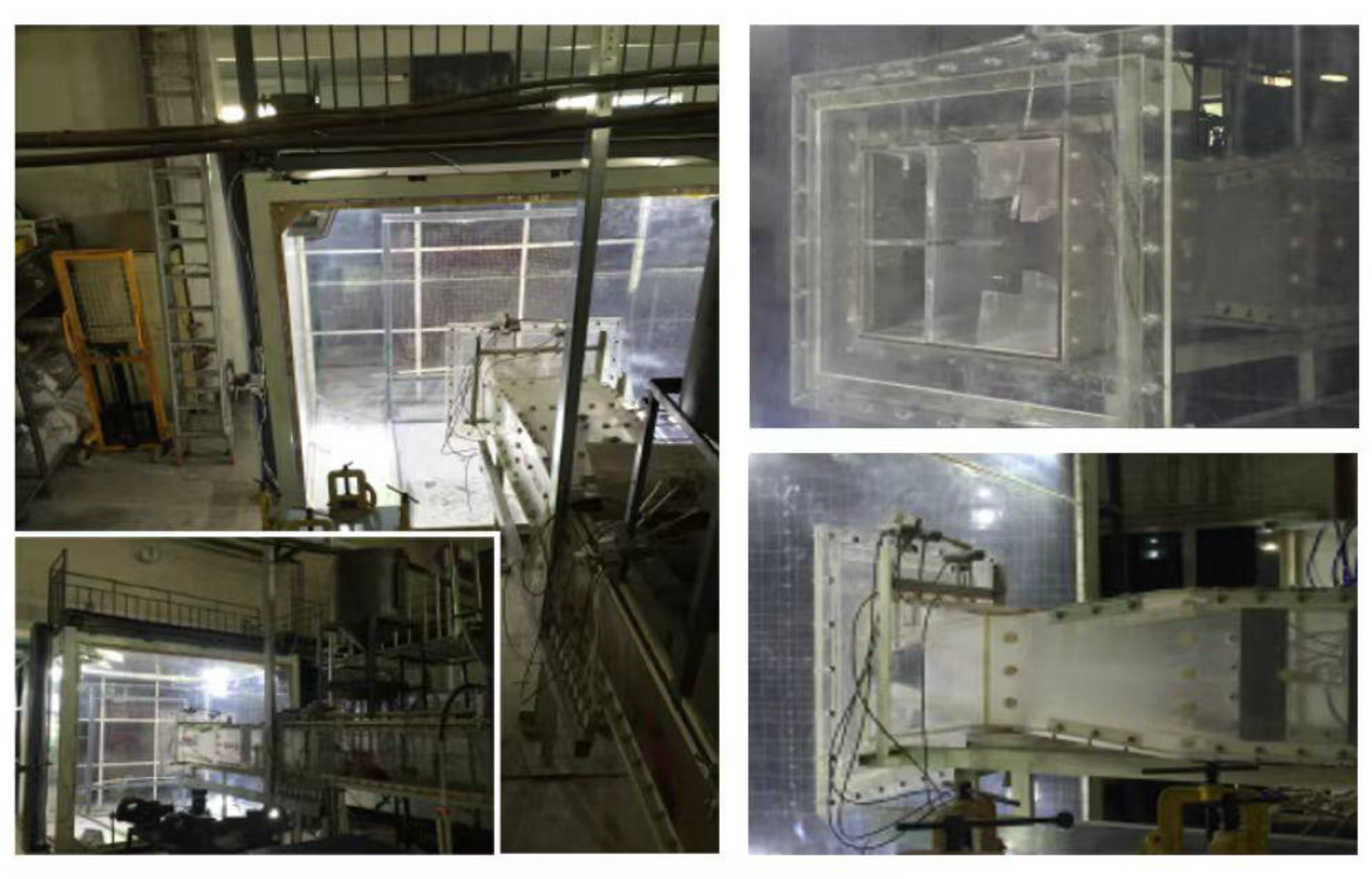
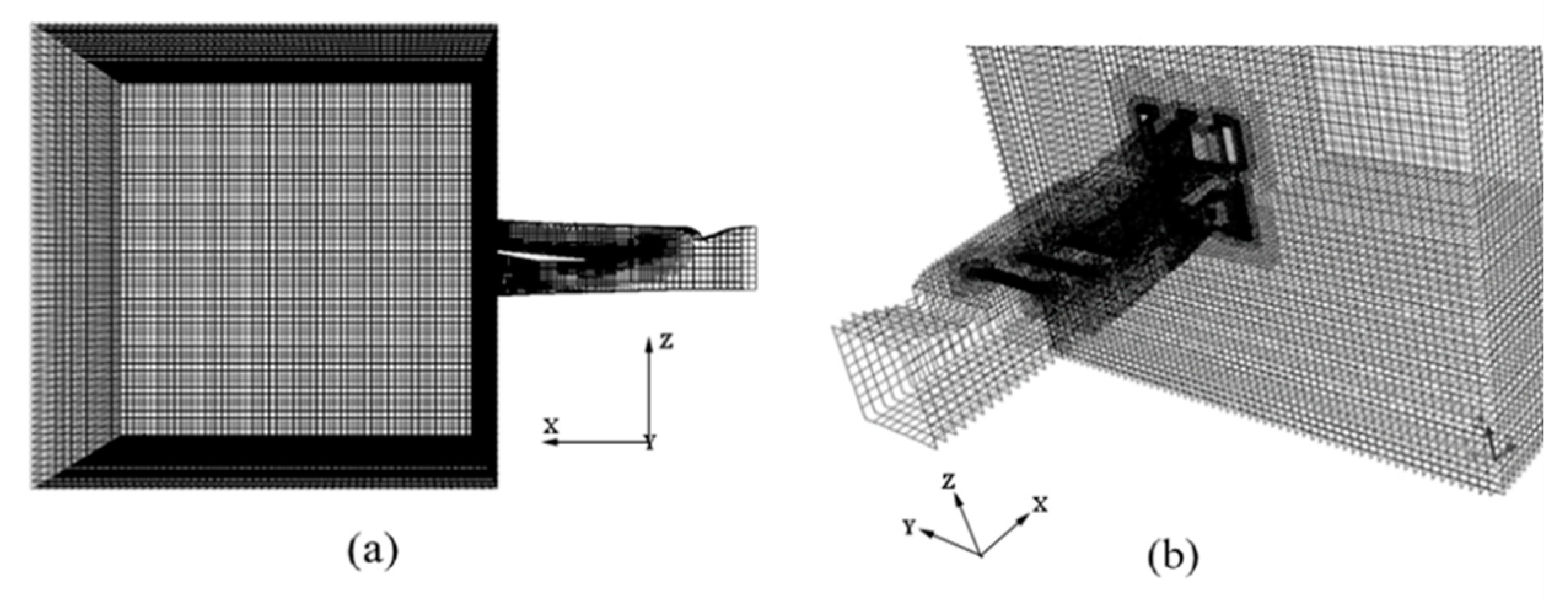

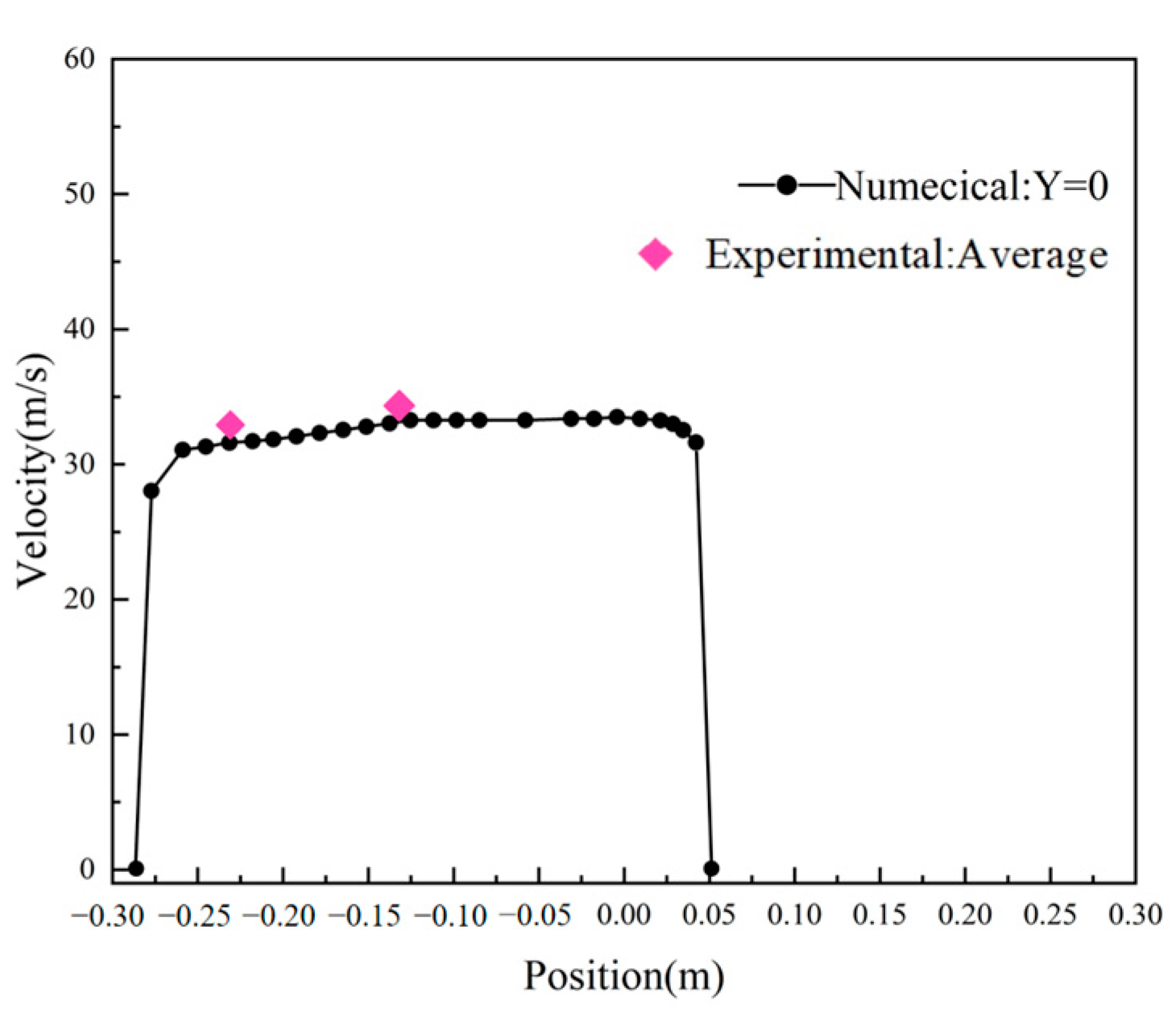
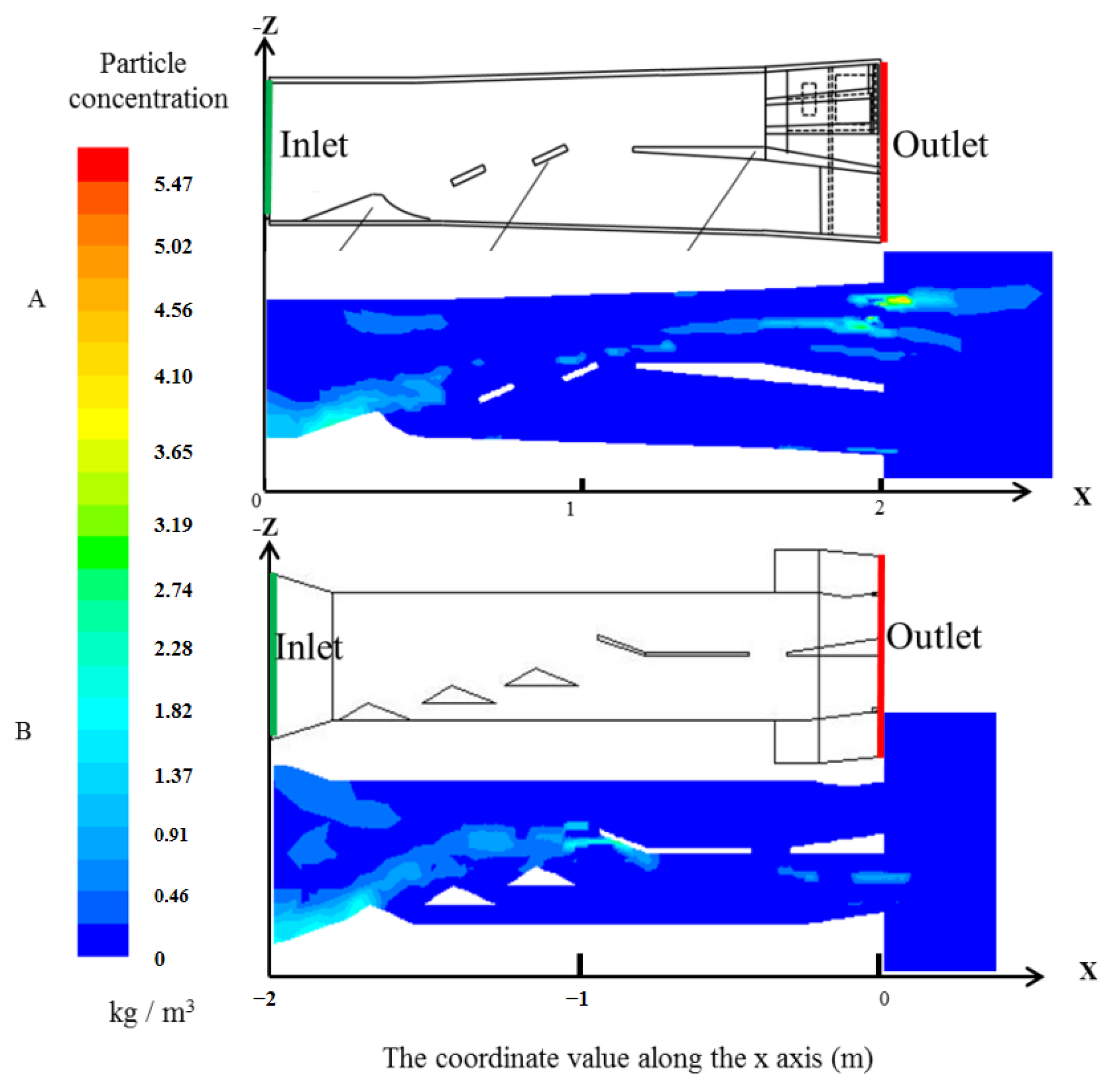
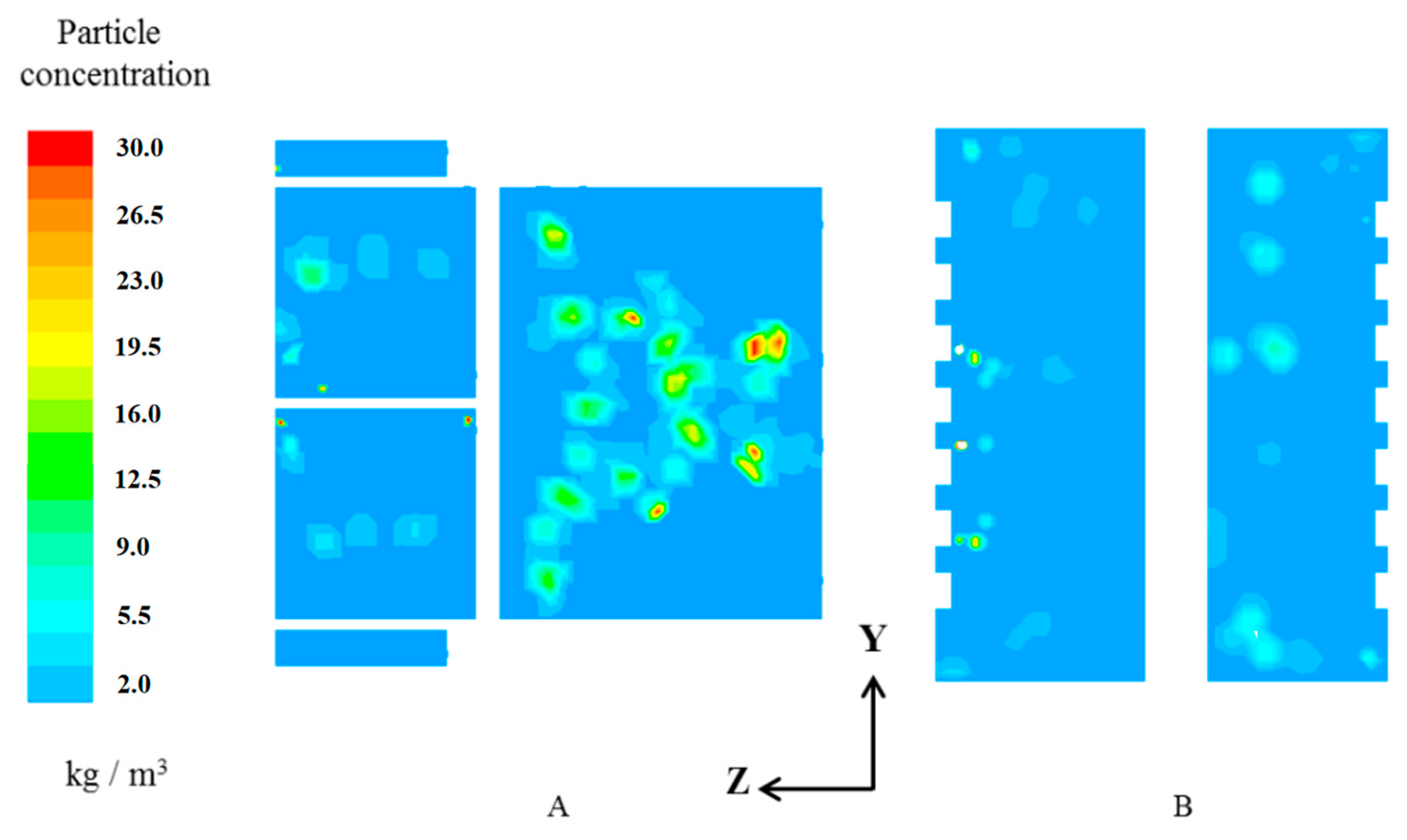
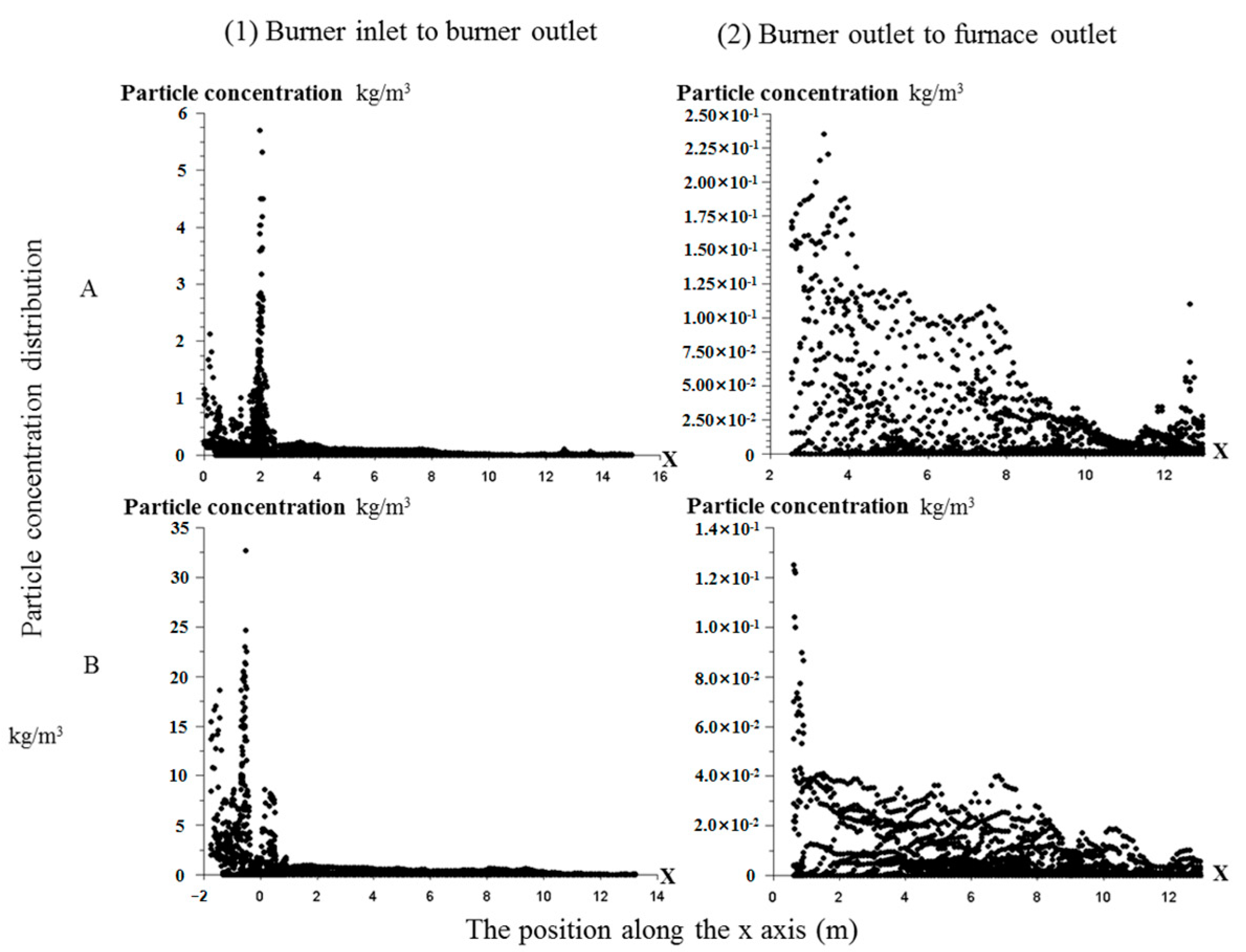

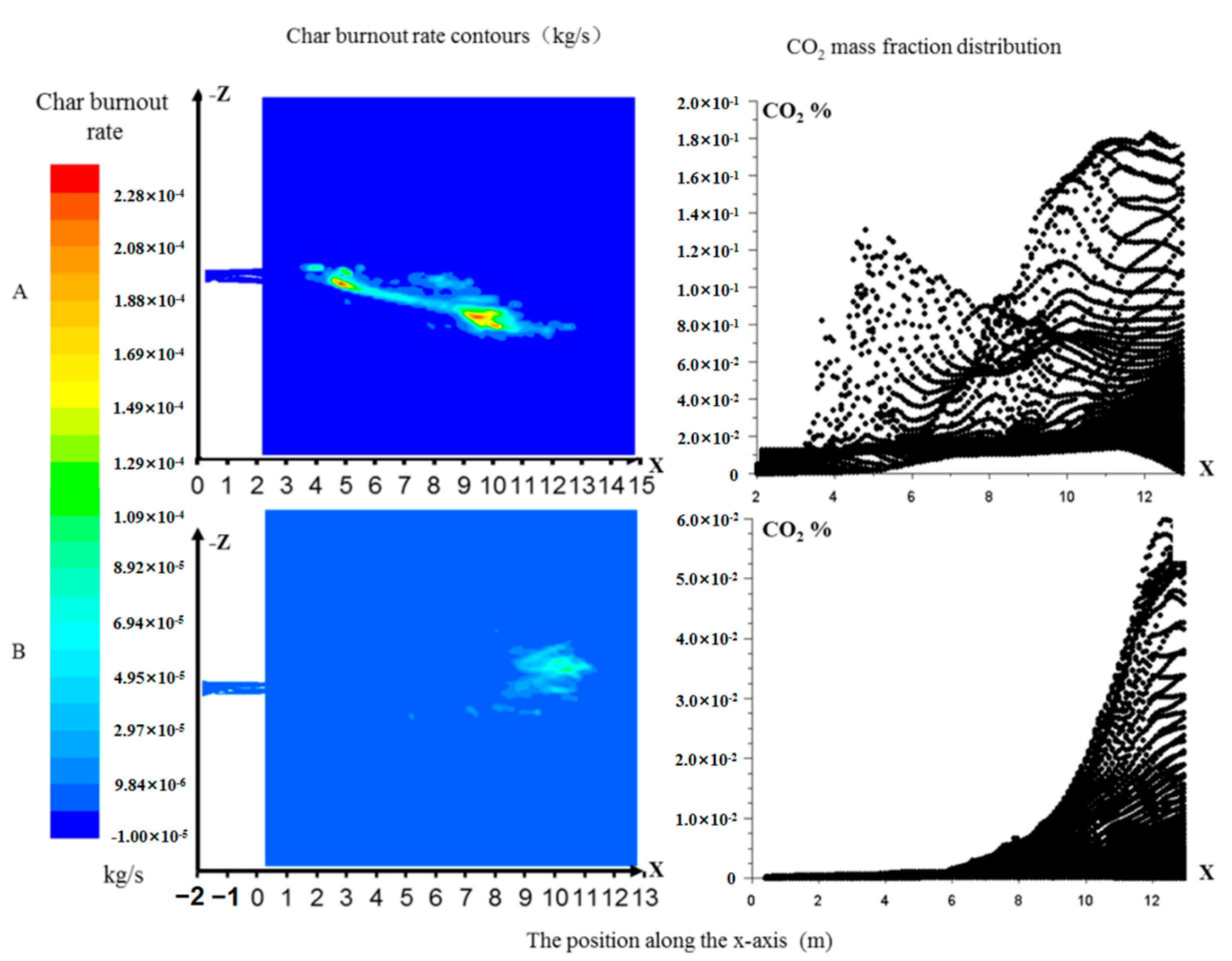
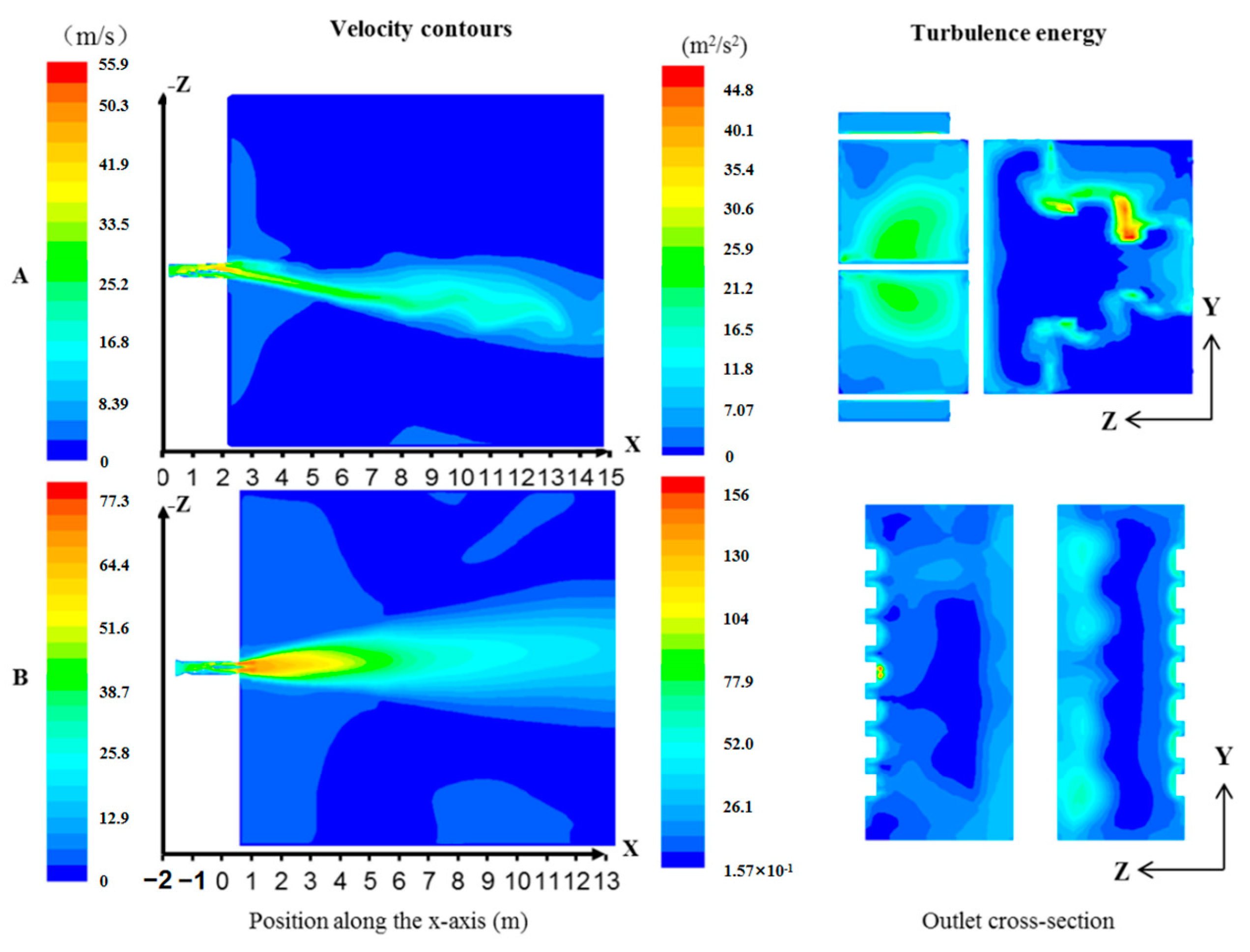

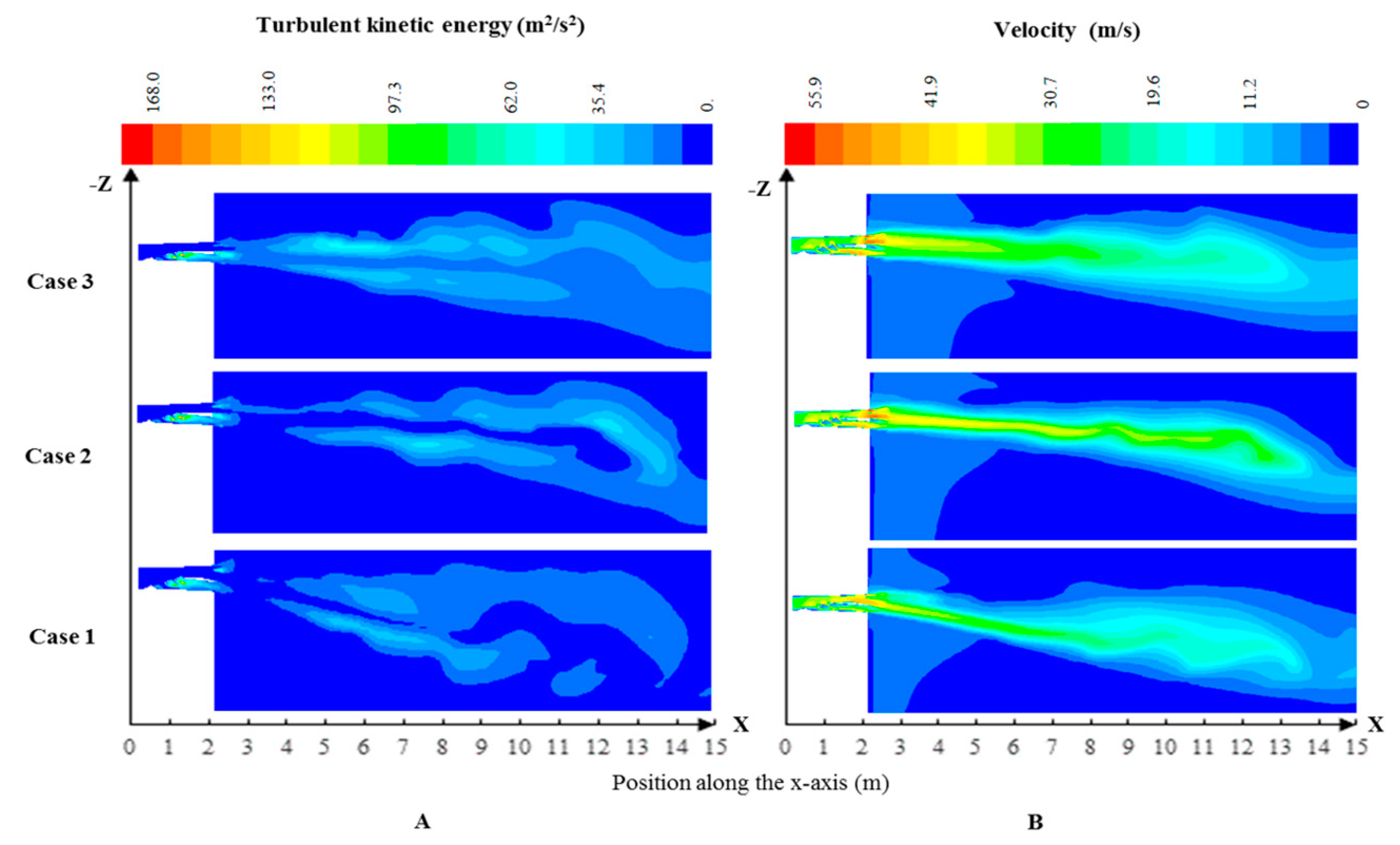




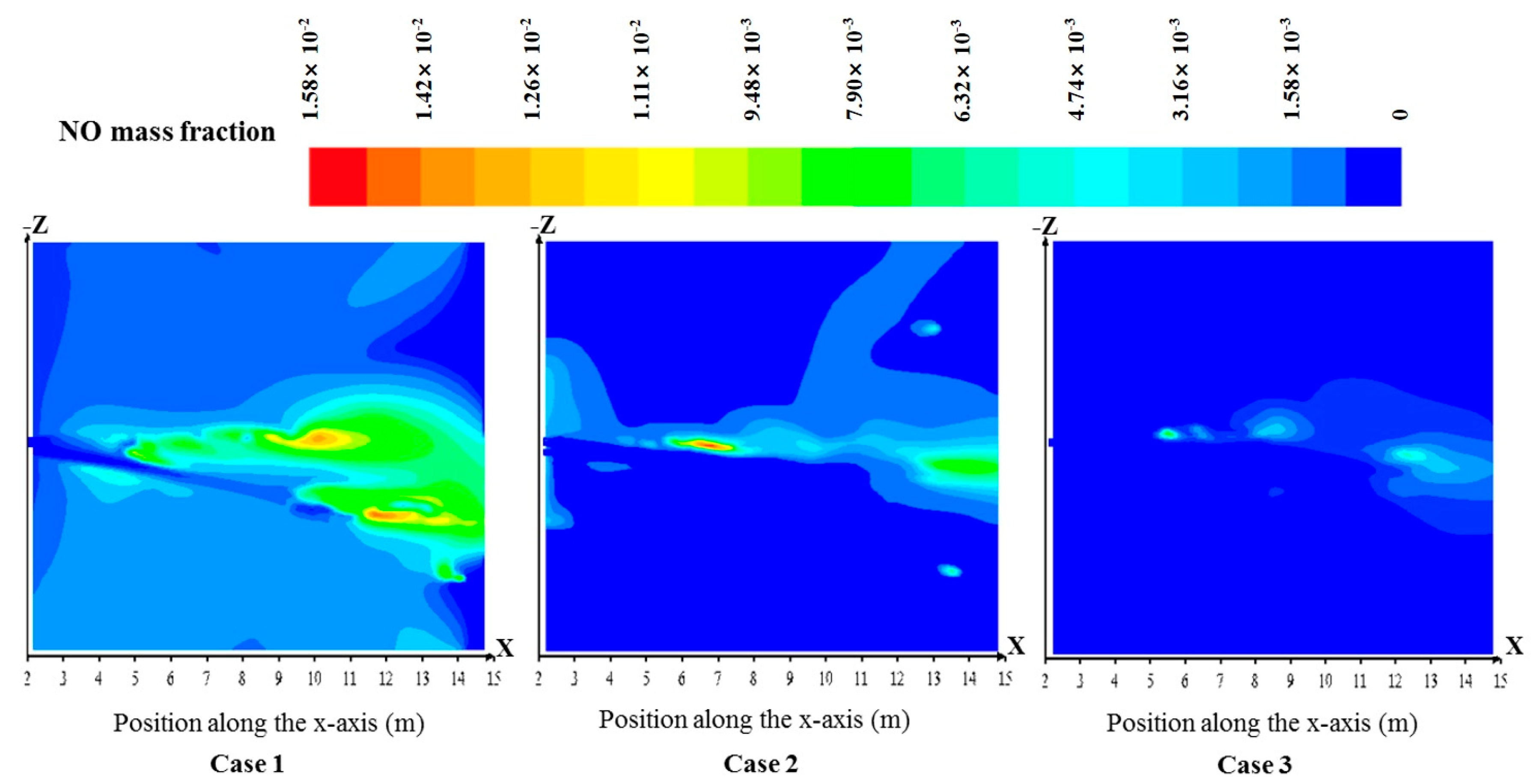
| Simulation Object | Model/Algorithm Selection |
|---|---|
| Turbulent flow | Realizable k-ε two-equation model |
| Gas–solid two-phase turbulent flow | Lagrangian particle trajectories model |
| Radiation | P-1 model |
| Devolatilization | Two-competing rate model |
| Gas-phase turbulent combustion | PDF model |
| Char surface combustion | Kinetic/diffusion surface reaction rate model |
| The fuel NOx formation | De Soete mechanisms |
| The thermal NOx formation | Extended Zeldovich mechanisms |
| Sample | Proximate Analysis (wt%) | Qnet,ar (kcal·kg−1) | |||
|---|---|---|---|---|---|
| Mar | Ad | Vd | FCd | ||
| Meager coal | 5.67 | 29.20 | 12.49 | 58.31 | 5497.00 |
| Case | Angles | Rich/Lean Side | Cross Area [m2] |
|---|---|---|---|
| 1 | Tilt to lean side 10° | Rich | 0.08876 |
| Lean | 0.09167 | ||
| 2 | 0° | Rich | 0.06117 |
| Lean | 0.09167 | ||
| 3 | Tilt to rich side 3° | Rich | 0.05298 |
| Lean | 0.09167 |
| Rq | Rc | Rn | |
|---|---|---|---|
| DLNB | 1.30 | 16.30 | 0.20 |
| LNB | 1.04 | 1.37 | 0.03 |
| Case | Rich/Lean Side | kg·(kg·Air)−1 | Equivalent Ratio | Rc | Rq | Rv | |
|---|---|---|---|---|---|---|---|
| 1 | rich | Cn | 0.71 | 1.04 | 16.28 | 1.30 | 1.39 |
| lean | Cd | 0.04 | 0.06 | ||||
| 2 | rich | Cn | 1.43 | 2.10 | 22.94 | 0.85 | 1.29 |
| lean | Cd | 0.06 | 0.09 | ||||
| 3 | rich | Cn | 0.42 | 0.62 | 15.42 | 0.71 | 1.24 |
| lean | Cd | 0.03 | 0.04 |
Disclaimer/Publisher’s Note: The statements, opinions and data contained in all publications are solely those of the individual author(s) and contributor(s) and not of MDPI and/or the editor(s). MDPI and/or the editor(s) disclaim responsibility for any injury to people or property resulting from any ideas, methods, instructions or products referred to in the content. |
© 2023 by the authors. Licensee MDPI, Basel, Switzerland. This article is an open access article distributed under the terms and conditions of the Creative Commons Attribution (CC BY) license (https://creativecommons.org/licenses/by/4.0/).
Share and Cite
Wang, J.; Yang, J.; Yang, F.; Cheng, F. Numerical and Experimental Investigation of the Decoupling Combustion Characteristics of a Burner with Flame Stabilizer. Energies 2023, 16, 4474. https://doi.org/10.3390/en16114474
Wang J, Yang J, Yang F, Cheng F. Numerical and Experimental Investigation of the Decoupling Combustion Characteristics of a Burner with Flame Stabilizer. Energies. 2023; 16(11):4474. https://doi.org/10.3390/en16114474
Chicago/Turabian StyleWang, Jing, Jingchi Yang, Fengling Yang, and Fangqin Cheng. 2023. "Numerical and Experimental Investigation of the Decoupling Combustion Characteristics of a Burner with Flame Stabilizer" Energies 16, no. 11: 4474. https://doi.org/10.3390/en16114474
APA StyleWang, J., Yang, J., Yang, F., & Cheng, F. (2023). Numerical and Experimental Investigation of the Decoupling Combustion Characteristics of a Burner with Flame Stabilizer. Energies, 16(11), 4474. https://doi.org/10.3390/en16114474









